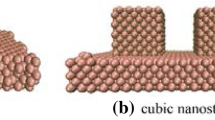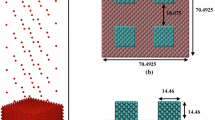Abstract
The aim of this study is to investigate the effects of Al and Cu nanostructures on the explosive boiling of a thin layer of liquid argon atoms on the Al and Cu substrates using molecular dynamics method. The results indicate that employing cone-shaped nanostructured surfaces leads to creation of thinner primary liquid layer as compared to the common Al or Cu smooth surfaces. Results show that using a cone-shaped nanostructured surface leads to a higher heat transfer rate and subsequently faster evaporating rate of the liquid layers due to increase in the solid–liquid contact area. In addition, it was found that Cu nanostructure has a more effective role in amplifying the explosive boiling, in comparison with Al nanostructure. The results further show that using the Al and Cu cone-shaped nanostructures on an Al smooth surface can increase the heat transfer by 29% and 38.7%, respectively.










Similar content being viewed by others
References
Ogoh W, Groulx D. Effects of the heat transfer fluid velocity on the storage characteristics of a cylindrical latent heat energy storage system : a numerical study. Heat Mass Transf. 2012;48(3):439–49.
Akram N, Sadri R, Kazi SN, Ahmed SM, Zubir MNM, Ridha M, et al. An experimental investigation on the performance of a flat-plate solar collector using eco-friendly treated graphene nanoplatelets–water nanofluids. J Therm Anal Calorim. 2019;138:609–21.
György S, Károly Z, Fazekas P, Németh P, Bódis E, Menyhárd A, et al. Effect of the reaction temperature on the morphology of nanosized HAp. J Therm Anal Calorim. 2019;138:145–51.
Yu Q, Lu Y, Zhang C, Wu Y, Sunden B. Experimental and numerical study of natural convection in bottom-heated cylindrical cavity filled with molten salt nanofluids. J Therm Anal Calorim. 2019;18:1–3.
Awad AH. Modeling nanostructure lattice thermal conductivity. J Therm Anal Calorim. 2015;119:1459–67.
Kumar V, Sarkar J. Research and development on composite nanofluids as next-generation heat transfer medium. J Therm Anal Calorim. 2019;137:1133–54.
Jegadheeswaran S, Sundaramahalingam A, Pohekar SD. High-conductivity nanomaterials for enhancing thermal performance of latent heat thermal energy storage systems. J Therm Anal Calorim. 2019;138:1137–66.
Vasquez ES, Prehn EM, Walters KB. Assessing magnetic iron oxide nanoparticle properties under different thermal treatments. J Therm Anal Calorim. 2019;41:1–2. https://doi.org/10.1007/s10973-019-09195-4.
Setoodeh H, Keshavarz A, Ghasemian A, Nasouhi A. Subcooled flow boiling of alumina/water nanofluid in a channel with a hot spot: an experimental study. Appl Therm Eng. 2015;90:384–94.
Jiang X, Ling C, Wang Z, Lu J. The effect of Cu–Zn distribution in zincian malachite on the formation of individual CuO and ZnO particles. J Therm Anal Calorim. 2019;137:1519–25.
Pourrajab R, Noghrehabadi A, Behbahani M, Hajidavalloo E. An efficient enhancement in thermal conductivity of water-based hybrid nanofluid containing MWCNTs-COOH and Ag nanoparticles: experimental study. J Therm Anal Calorim. 2020;16:1–3.
Ramezanizadeh M, Alhuyi Nazari M, Ahmadi MH, Lorenzini G, Pop I. A review on the applications of intelligence methods in predicting thermal conductivity of nanofluids. J Therm Anal Calorim. 2019;138:827–43.
Keklikcioglu CN. The impact of surfactants on the stability and thermal conductivity of graphene oxide de-ionized water nanofluids. J Therm Anal Calorim. 2019;139(3):1895–902.
Lu Q, Mao SS, Mao X, Russo RE. Delayed phase explosion during high-power nanosecond laser ablation of silicon. Appl Phys Lett. 2002;80:3072–4.
Yoo JH, Jeong SH, Mao XL, Greif R, Russo RE. Evidence for phase-explosion and generation of large particles during high power nanosecond laser ablation of silicon. Appl Phys Lett. 2000;76:783–5.
Kudryashov SI, Allen SD. Submicrosecond dynamics of water explosive boiling and lift-off from laser-heated silicon surfaces. J Appl Phys. 2006;100:104908.
Karim ET, Lin Z, Zhigilei L V. Molecular dynamics study of femtosecond laser interactions with Cr targets. In: AIP conference proceedings. American Institute of Physics. 2012; pp. 280–93.
Park HK, Grigoropoulos CP, Poon CC, Tam AC. Optical probing of the temperature transients during pulsed-laser induced boiling of liquids. Appl Phys Lett. 1996;68:596–8.
Karabutov AA, Kubyshkin AP, Panchenko VY, Podymova NB. Dynamic shift of the boiling point of a metal under the influence of laser radiation. Quantum Electron. 1995;25:789–93.
Dou Y, Zhigilei LV, Winograd N, Garrison BJ. Explosive boiling of water films adjacent to heated surfaces: a microscopic description. Washington, DC: American Chemical Society; 2001.
Sheikholeslami M, Rezaeianjouybari B, Darzi M, Shafee A, Li Z, Nguyen TK. Application of nano-refrigerant for boiling heat transfer enhancement employing an experimental study. Int J Heat Mass Transf. 2019;141:974–80.
Shafee A, Rezaeianjouybari B, Sheikholeslami M, Allahyari M, Babazadeh H. Boiling process with incorporating nanoparticles through a flattened channel using experimental approach. J Therm Anal Calorim. 2020;24:1–8.
Gu X, Urbassek HM. Atomic dynamics of explosive boiling of liquid–argon films. Appl Phys B. 2005;81:675–9.
Das S, Saha B, Bhaumik S. Experimental study of nucleate pool boiling heat transfer of water by surface functionalization with crystalline TiO2 nanostructure. Appl Therm Eng. 2017;113:1345–57.
Dou Y, Zhigilei LV, Winograd N, Garrison BJ. Explosive boiling of water films adjacent to heated surfaces: a microscopic description. J Phys Chem A. 2001;105:2748–55.
Yao Z, Lu YW, Kandlikar SG. Effects of nanowire height on pool boiling performance of water on silicon chips. Int J Therm Sci. 2011;50:2084–90.
Kamel MS, Lezsovits F, Hussein AK. Experimental studies of flow boiling heat transfer by using nanofluids. J Therm Anal Calorim. 2019;138:4019–43.
Chen R, Lu MC, Srinivasan V, Wang Z, Cho HH, Majumdar A. Nanowires for enhanced boiling heat transfer. Nano lett. 2009;9(2):548–53.
Betz AR, Xu J, Qiu H, Attinger D, Betz AR, Xu J, et al. Do surfaces with mixed hydrophilic and hydrophobic areas enhance pool boiling ? Do surfaces with mixed hydrophilic and hydrophobic areas enhance pool boiling ? Appl Phys Lett. 2013;141909:2012–5.
Dong L, Quan X, Cheng P. An experimental investigation of enhanced pool boiling heat transfer from surfaces with micro/nano-structures. Int J Heat Mass Transf. 2014;71:189–96.
Reza Seyf H, Zhang Y. Molecular dynamics simulation of normal and explosive boiling on nanostructured surface. J Heat Transf. 2013;135:121503.
Weirong W, Shenghong H, Xisheng L. International Journal of Heat and Mass Transfer MD simulation on nano-scale heat transfer mechanism of sub-cooled boiling on nano-structured surface. Int J Heat Mass Transf. 2016;100:276–86.
Seyf HR, Zhang Y. Effect of nanotextured array of conical features on explosive boiling over a flat substrate: a nonequilibrium molecular dynamics study. Int J Heat Mass Transf. 2013;66:613–24.
Morshed AKMM, Paul TC, Khan JA. Effect of nanostructures on evaporation and explosive boiling of thin liquid films: a molecular dynamics study. Appl Phys A. 2011;105:445–51.
Yamamoto T, Matsumoto M. Initial stage of nucleate boiling: molecular dynamics investigation. J Therm Sci Technol. 2012;7:334–49.
Schoen PAE, Poulikakos D, Arcidiacono S. Phase change of a confined subcooled simple liquid in a nanoscale cavity. Phys Rev E Stat Nonlinear Soft Matter Phys. 2005;71(4):041602.
Fu T, Mao Y, Tang Y, Zhang Y, Yuan W. Molecular dynamics simulation on rapid boiling of thin water films on cone-shaped nanostructure surfaces. Nanoscale Microscale Thermophys Eng. 2015;19:17–30.
Wang Y-H, Wang S-Y, Lu G, Wang X-D. Explosive boiling of nano-liquid argon films on high temperature platinum walls: effects of surface wettability and film thickness. Int J Therm Sci. 2018;132:610–7.
Yi P, Poulikakos D, Walther J, Yadigaroglu G. Molecular dynamics simulation of vaporization of an ultra-thin liquid argon layer on a surface. Int J Heat Mass Transf. 2002;45:2087–100.
Qanbarian M, Qasemian A, Arab B. Molecular dynamics simulation of enhanced heat transfer through conical Al/Cu nanostructures. Comput Mater Sci. 2020;180:109710.
Xu Z, Ge D, Zhang L. Simulation and prediction on phonon thermal conductivity of Al/Cu interface. J Phys Chem Solids. 2018;122:184–8.
Watanabe H, Ito N, Hu C-K. Phase diagram and universality of the Lennard–Jones gas–liquid system. J Chem Phys. 2012;136:204102.
Zabaloy MS, Vasquez VR, Macedo EA. Description of self-diffusion coefficients of gases, liquids and fluids at high pressure based on molecular simulation data. Fluid Phase Equilib. 2006;242:43–56.
Zhang S, Hao F, Chen H, Yuan W, Tang Y, Chen X. Molecular dynamics simulation on explosive boiling of liquid argon film on copper nanochannels. Appl Therm Eng. 2017;113:208–14.
Nejatolahi M, Golneshan AA, Kamali R, Sabbaghi S. Nonequilibrium versus equilibrium molecular dynamics for calculating the thermal conductivity of nanofluids. J Therm Anal Calorim. 2020;5:1–5.
Mao Y, Zhang Y. Molecular dynamics simulation on rapid boiling of water on a hot copper plate. Appl Therm Eng. 2014;62:607–12.
Plimpton S. Fast parallel algorithms for short-range molecular dynamics. J Comput Phys. 1995;117:1–19.
Berendsen HJC, Postma JPM, Van Gunsteren WF, Dinola A, Haak JR, Berendsen HJC, et al. Molecular dynamics with coupling to an external bath Molecular dynamics with coupling to an external bath. J Chem Phys. 1984;81(8):3684–90.
Zhang H, Li C, Zhao M, Zhu Y, Wang W. Influence of interface wettability on normal and explosive boiling of ultra-thin liquid films on a heated substrate in nanoscale: a molecular dynamics study. Micro Nano Lett. 2017;12:843–8.
Diaz R, Guo Z. Molecular dynamics study of wettability and pitch effects on maximum critical heat flux in evaporation and pool boiling heat transfer. Numer Heat Transf Part A Appl. 2017;72:891–903.
Author information
Authors and Affiliations
Corresponding author
Additional information
Publisher's Note
Springer Nature remains neutral with regard to jurisdictional claims in published maps and institutional affiliations.
Rights and permissions
About this article
Cite this article
Qasemian, A., Qanbarian, M. & Arab, B. Molecular dynamics simulation on explosive boiling of thin liquid argon films on cone-shaped Al–Cu-based nanostructures. J Therm Anal Calorim 145, 269–278 (2021). https://doi.org/10.1007/s10973-020-09748-y
Received:
Accepted:
Published:
Issue Date:
DOI: https://doi.org/10.1007/s10973-020-09748-y




